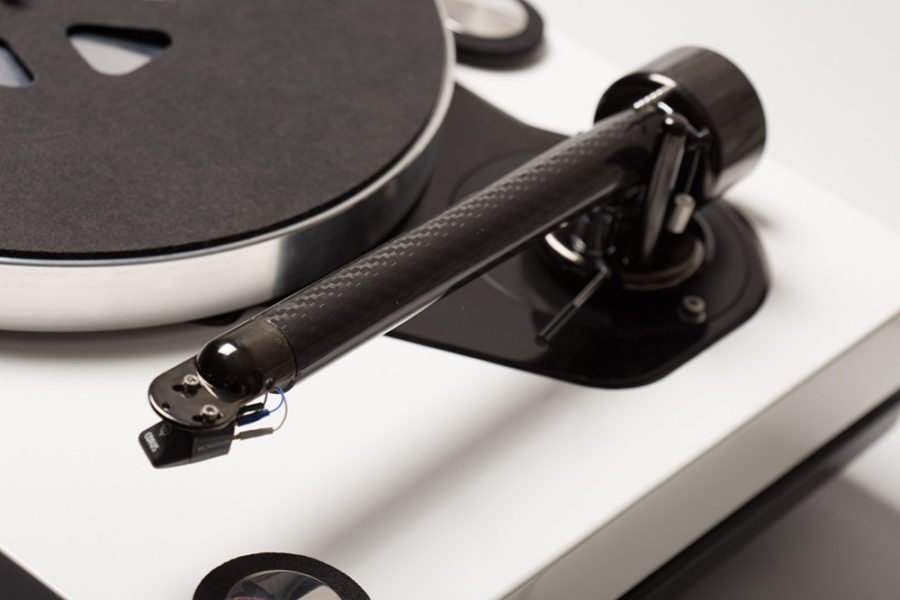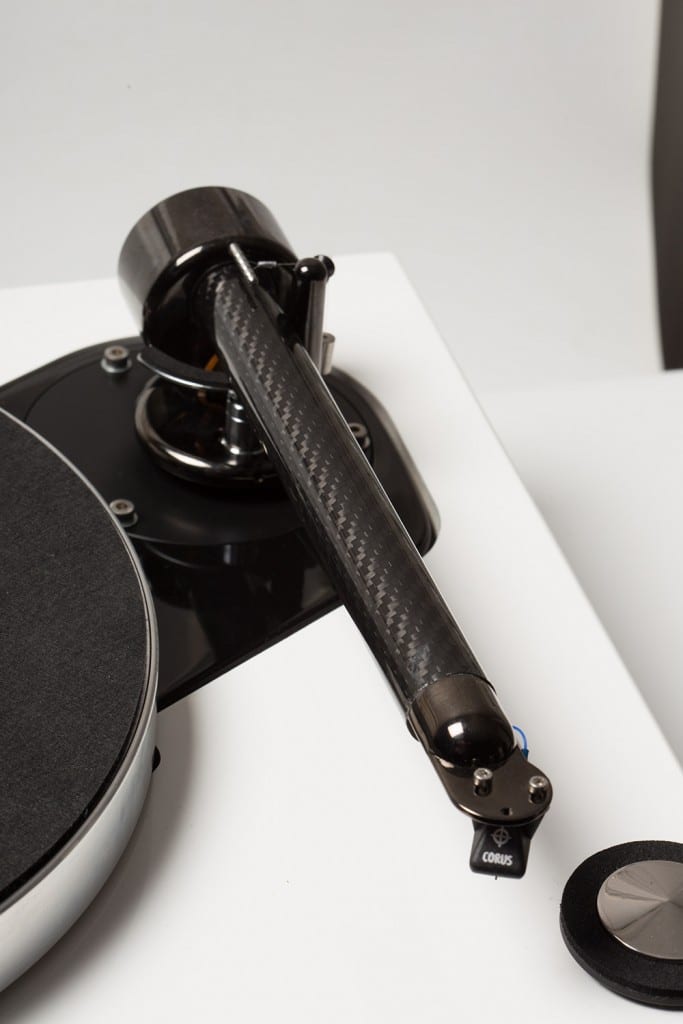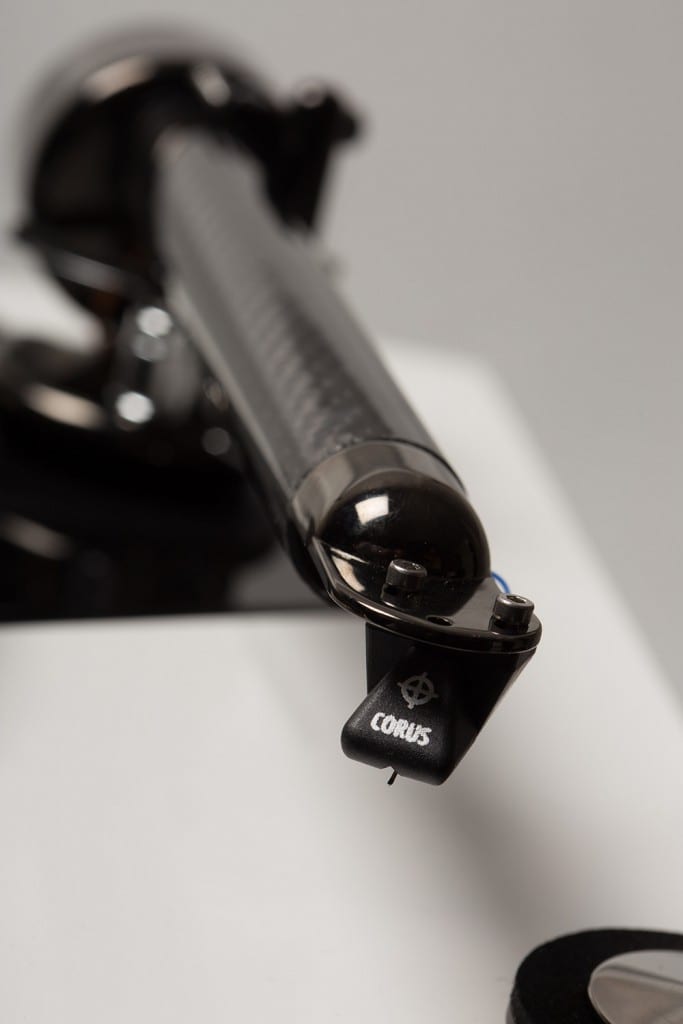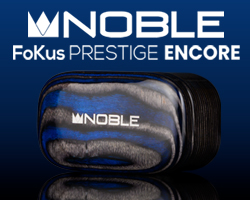Janine Elliot takes a listen to Roksan’s latest version of the iconic Xerxes, this time in its 20Plus guise and with the Caspian RPM Speed Control and innovative Pug tonearm. Price for this package is £5825
Vinyl has been an important part of my life and I’m pleased to say still is. From my earliest Garrard SP25/iii to my collection of almost 20 record players today, it is still my “go to” choice for high quality audio reproduction. I was never taken in by the brilliant PR from Linn Sondek, a turntable that goes all the way back to 1972, rather sticking to Garrard 301 and Thorens TD160. Interestingly these two had opposing platform topologies; one solid and the other sprung isolation. And that leads me nicely into the Roksan Xerxes 20Plus, which well, combines two methods in one amazingly complex engineering masterpiece.
When the original London manufactured’ Xerxes came onto the scene in 1985, incidentally named after the Persian King, I really liked the look of it and was almost hooked, but university fees and getting married put a stop to that idea. Whilst my own marriage didn’t last, I am pleased to say the Xerxes has kept on going and is now in its 31st year. And whilst the LP12 has had more facelifts than Joan Rivers, I still have never been a fan, although it sounds more controlled and accurate now than it did when it was a baby. The original Xerxes seemed a much better behaved child then, and now 31 years later I still wasn’t disappointed. Let me stress, though, that this 20Plus is not a modified Xerxes from ’85; this machine is largely based on their top of the range TMS3, only without the hefty price tag. My white Xerxes for review arrived complete with the new PUG arm and the Caspian RPM power-supply and speed selector unit, all totalling £5825.
I have wanted to review the £1375 PUG, which sits pricewise between the Nima and Artemiz tonearms, ever since first setting eyes on this overfed animal. PUG is a most apt name here. Its name sounds clumsy, and I have to say at first impressions the PUG looks like it needs to go on a diet pretty damn fast. But this look is part of what makes this tonearm something very special. In the dictionary PUG can mean an oversized ugly Chinese or boxer dog, or “to make soundproof by covering or packing with clay, mortar, sawdust, or felt”. Whilst such materials most definitely haven’t been packed inside, the carbon-fibre makes for a very rigid and lightweight arm, ideal for my very diminutive Ortofon Kontrapunkt b cartridge. Put next to my anorexic SME3s from 1980, the 22mm diameter carbon fibre arm tube looks highly clumsy, though I quickly got to know and love this unipivot design. This was no dog, but rather a tiger, full of energy and bite, though it was very tame to set up, unlike the aged SME series 3. Roksan even provide a stylus balance with the Pug to assist set-up. Height adjustment from the supplied Allen key was easy and bias was set up with ease, though the fact the weight rubs against the arm when near the centre of the record (see photo) made me a little alarmed. Indeed for most of the review I removed it completely.
Of course, using Carbon fibre is not a new idea, or indeed having such large diameter tubing, though the tapered Wilson Benesch A.C.T tonearm is more petite in appearance.
Whilst the arm didn’t do itself any favours in the looks department, the Caspian RPM speed controller is the same beautiful shape as the complete Caspian range. I have to admit love at first sight when I first ever met the Caspian range down Tottenham Court Road, London, in the good old days. The RPM doesn’t have the iconic semi-spherical knobs, but its matt black frontage and “Roksan” etched top aluminium cover made it look more than its £1450 asking price. This unit has a mains switch craftily hidden underneath, with stop/start switch and a speed selector to change between 33.3 and 45 rpm in the centre front, all aided by an LED that changes colour depending on what speed is set. For 33rpm the light will be blue and red for 45rpm, and when not revolving is a lovely purple mixture of the two. The unit is the replacement for the discontinued DX2 and an alternative to the XPS7 power unit, and presently part of a range with the RPP phono preamplifier or the VCS/ VCS 25 which are a mixture of the RPP and RPM. The RPM employs a high quality crystal speed control system, which helps to keep a very stable playback speed; the Xerxes plays exceptionally well, showing no signs of speed fluctuation that my perfect-pitch can make out. Indeed with its digital speed control PCB it ensures those in countries with unstable or poor voltage are able to maintain the exact and correct speed by allowing an increase or decrease in the speed by up to 6.25%. Not that the Xerxes hasn’t always had a good reputation for speed accuracy.
The Xerxes 20 Plus is the latest reincarnation of the Xerxes showing the complexity of manufacture from the moment you get it out the box. With so much based on the TM3, its triple layer construction assures isolation between cartridge, motor and plinth. Using my seismometer, showed just how good this was at removing inherent vibrations. As mentioned earlier, this turntable is a mixture of fixed and isolated chassis, enabling the record surface to remain stationary and solid, but being in complete isolation from the rest of the deck. The lower platform connects directly to the three metal adjustable feet, and above this is placed the main (and on this occasion a shiny white) plinth isolated with three suspension mounts. There is a choice of beautiful Maple or Rosewood, or black and white. This top plinth then has an inner plinth which is kept detached from the outer to provide further isolation and needs to be adjusted with an Allen key to ensure the two are level. The inner plinth is connected to the main bearing and detachable arm-board which is made from Acetal. Each layer is therefore adjustable in all planes to get absolutely level, and therefore takes longer setting up than the PUG. The instruction booklet is very informative, explaining the design and listing of all parts as well as the assembly, but you really need to read it all first before you start assembling, as it can be a bit like assembling furniture. I suggest a cup of coffee first. The motor is detached from this inner plinth, and indeed the motor itself is sprung so that just the right amount of torque on the flat belt is provided, particularly viable as record groove modulations vary with dynamics creating different stresses on the motor.
Coming straight from the TMS3 the self-centring and self-aligning single point main bearing is of a surprisingly small diameter, with the gap between the spindle and bearing sleeve a miniscule 1/5,000”! The only contact is between the spindle tip and the captive tungsten Carbide ball bearing. The spindle is attached to the inner platter with the outer platter resting on top of this. The theme of decoupling continues with the mat sitting on top of the platter and not being attached to the spindle; when you put the record on the platter you need the spindle in situ, but then you remove it before you start to play (and remember to clean the record before you do all this!). This is an old trick going back to the beginnings of Xerxes, but it means that you can never use a record clamp. Unlike the LP12, you cannot take a first generation Xerxes and turn it into a 20+, especially the new platter, but a few of the modifications, such as bearing and mat, can be employed to bring it somewhere near the 20+ in performance. All in all, then, one of the most carefully thought out turntable design there is.
LISTENING
My immediate opinion of this three-piece setup was of scale of musicality and harmony. There was immense dynamics, and timing and resolution. Sibelius 4th symphony (Karajan, Berliner Philharmoniker, Deutsche Grammophon) was as open and with as big a dynamic range as I have ever heard, and therefore more akin to CD, with the arm and turntable combination giving a very exact but musical performance. The instruments were positioned with excellent accuracy both in width and depth. Moving to Goldfrapp ‘Tales of Us’ this spaciousness continued further in the ethereal first track “Jo”, and the bass thumps in the third track “Drew” drew me closer in to the music than I expected, with a tighter and better controlled bass. Moving to my ancient live album “Feel the Love”, the audience applause was as clear and natural as I have ever heard. I wish I had been at that concert in the US, but I was pretty close now.
Bowie’s ‘Blackstar’ title track is a complicated number, with intricate drum rhythms fighting for survival against a maze of Indian ragas and simplistic 4/4 time. Whilst each idea was battling for predominance, the Xerxes combination made it all so easy to digest. My Kontrupunkt showed just how good it was in retrieving information from the grooves. Indeed, again there was an almost CD-like quality in terms of clarity and detail, though with musicality that 16/44.1 just cannot give. Turning to Jazz showed again the ease at which this turntable played whatever style I played; Patricia Barber “Live in Paris” had intricate detail of the drumming and clarity in the vocals that vinyl does so well. After a few Queen albums I was saddened to have to pack it all up into the box to send back to London.
CONCLUSION
This might have its origins in 1985, but this is no modified 31 year old design. This is a TMS3 on the cheap, and for £3000 plus power supply represents an extremely sound investment. As a combination under £6000 the micro-detail of sound retrieval was simply wonderful and if I felt the need to have another turntable would have no qualms about opening my purse.
All I played was effortless, with nothing standing out or missing. Dynamics and soundstage were as good as I have heard, and what’s more it looked so good!
Value for Money (Xerxes plus RPM and PUG): 8.8/10
Build Quality: 8.8/10 (cannot fault the engineering)
Overall: 8.83/10
Price at time of review: £5825
Pros:
Excellent retrieval of detail
Dynamic range
Speed stability
Triple layer of isolation
Cons:
Instruction manual could be easier to read, perhaps with photos rather than diagrams. An on-line video to show set-up could be helpful.
The PUG isn’t the most beautiful arm.
Janine Elliot
Technical Spec’
Main Bearing Spindle: Hardened tool steel.
Roundness and Concentricity: <5 Microns
Length to Diameter Ration: 11:1
Main Bearing Ball: Super precision Tungsten Carbide
Roundness: <1 Micron
Diameter: 2mm
Main Bearing Housing: Solid Phosphor Bronze
Clearance: 2/1,0000”
Inner Platter: 2 piece Solid Aluminium alloy. Interference fitted and non-resonant
Outer Platter: 2 piece Solid Aluminium alloy. Interference fitted and non-resonant
Structure: 3Plinth Design
Isolation: 3 Level De-coupling
Motor: Custom made 24 pole synchronous
Pulley: Solid aluminium alloy
Roundness and Concentricity: <1 Micron
Drive Belt: Precision Ground Neoprene
Motor Mount: Unique synchronizing bearing
Motor Drive: External speed controller
Wow and Flutter: <0.02%
Rumble:<-80dB
Dimensions: 450 x 370 x 115
Weight: 12Kg
























































































































































































































You must be logged in to leave a reply.